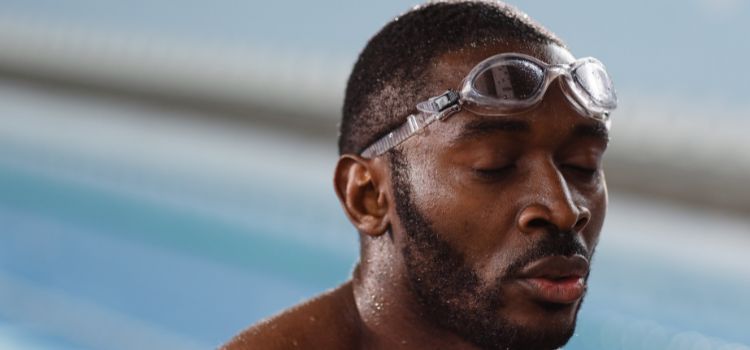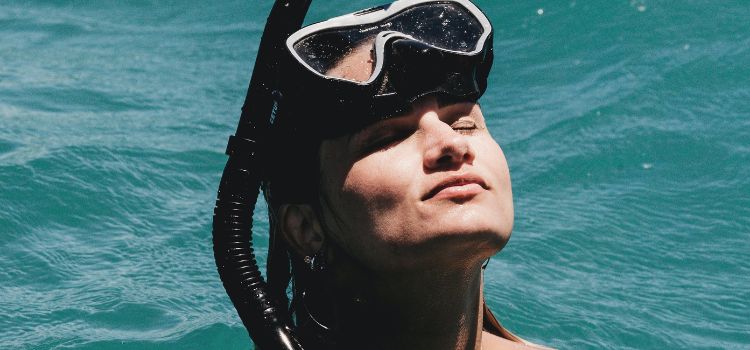As an Amazon Associate I earn from qualifying purchases.
Conjunctivitis, also known as pink eye, is a prevalent and highly transmissible ocular ailment that may arise from allergens, germs, or viruses. The infection results in red, unpleasant, and irritated eyes. It also frequently produces a discharge that may be green or yellow in hue. It’s normal to wonder if swimming is safe if you have pink eye, especially if you intend to wear goggles. We’ll go over the dangers and things to think about can you swim with pink eye if you wear goggles in this extensive guide.

Pink Eye Overview
It is important to know what pink eye is and how it is usually contracted before discussing swimming with goggles on the subject. As the name suggests, pink eye is when the conjunctiva or the white of the eye turns red or pink. This disease is differentiated by the burning of the conjunctivas blood vessels, which can cause a variety of painful symptoms such as red or pink eye.
- Inflammation, burning, or stinging in the eye.
- Excessively green, yellow, or clear ripping or discharge.
- Rusty lids, particularly first thing in the morning.
The main causes of the pink eye are given below:
- Viral infection: Viruses, such as those that cause the common cold, can incite viral conjunctivitis. This embrace is highly infectious and typically goes away on its own in a few days.
- Bacterial infections: Bacterial conjunctivitis occurs by a variety of germs. It can be very harmful so Antibiotics could be required for it.
- Symptoms of allergies: Allergens including dust, pollen, or pet dander can cause allergic conjunctivitis, which mimics a bacterial or viral infection. It is not communicable and typically affects both eyes.
- Chemical Irritation: Conjunctivitis can also result from exposure to irritants such strong cleaning products or chlorine from swimming pools.
It’s important to discuss if it’s safe to swim with pink eye given that swimming pools can irritate eyes, especially if goggles are being worn for protection.
Swimming with Pink Eye: Considerations
Whether or not to swim while having pink eye depends on a number of variables, and wearing goggles can help reduce some of the hazards. The following are the most important things to consider while considering swimming with pink eye while donning goggles:
Contagiousness:
If a bacterial or viral infection is the source of your pink eye, it is extremely communicable and you should avoid close contact with people, including sharing swimming pools. Although goggles can shield your eyes from water exposure, they cannot stop the virus from spreading to other people. Refusing to swim until the contagious period has passed—typically 1-2 weeks for viral conjunctivitis and until you’ve finished a full course of antibiotics for bacterial conjunctivitis—is imperative for being responsible and considerate toward other swimmers.
Chlorine and Irritants:
In swimming pools, chlorine is a frequent disinfectant, and exposure to it can irritate the eyes. Your eyes may already be sensitive and susceptible to further irritation if you have pink eye. By protecting your eyes from pool chemicals like chlorine, goggles might lessen the chance that your symptoms will worsen.
Comfort:
The itching and burning sensations associated with pink eye can be quite bothersome. Goggles can offer some protection, but if your eyes are already sore, it might not be the most pleasant choice to wear them for a lengthy amount of time. Wearing prescription swim goggles will enhance your swimming experience and how well you can handle wearing them.
Goggle Fit and Condition:
Make sure the goggles fit and are in good shape. They might not be very successful in keeping pool water out of your eyes if they are broken, worn, or don’t form a tight seal around them.
Self-Care:
Taking proper care of oneself and maintaining good hygiene are crucial for managing pink eye. This includes cleaning your eyes as directed by your healthcare practitioner, refraining from touching them, and washing your hands frequently. Make sure you adhere to these safety measures before and after your swim if you choose to swim with having pink eye.
Consult a Healthcare Professional:
It’s best to speak with a medical expert, such as an ophthalmologist or primary care physician, before making a choice so they can determine the exact type of pink eye you have, evaluate the severity of your problem, and provide you with tailored advice.
The advantages and disadvantages of Swimming with Pink Eye and Goggles

Let’s weigh the benefits and drawbacks of swimming with pink eye while wearing goggles so you can make an informed choice:
Advantages:
- Protection from Irritants: Goggles can serve as a barrier to shield your eyes from chemicals in pools and chlorine, which can aggravate pink eye symptoms.
- Ongoing Exercise: For many people, swimming is a great way to unwind and exercise. If you have pink eye, you can still continue with your exercise regimen if you use goggles.
- Privacy and Comfort: You can enjoy your swim more without having to show your eyes to other people when wearing goggles, which can offer some privacy and comfort.
Disadvantages:
- Contagiousness: Even with goggles, you run the danger of infecting others with bacterial or viral pink eye. This can be especially troublesome in communal swimming areas.
- Goggle Discomfort: If your eyes are already irritated, goggles might not be the most pleasant choice. They might put pressure on your eye, making it more uncomfortable.
- Moist Environment: The moist environment that goggles can produce around your eyes may not be the best for treating pink eye because the bacteria or virus that causes the infection might flourish in such circumstances.
- Limited Vision: Wearing goggles might obstruct your vision, making it harder to see properly when swimming. This may raise the possibility of mishaps or run-ins with other swimmers.
- Possibility of Fogging: Goggles may fog up, which would further reduce visibility and take away from the fun of swimming.
Best Practices for Swimming with Pink Eye
It’s crucial to adhere to these basic practices if you choose to swim with pink eye while wearing goggles in order to reduce the dangers and guarantee a fun and safe experience:

- Speak with a Medical Professional: Consult a medical expert for advice on identifying the kind and severity of your pink eye. Observe their advice and treatment schedule.
- Select the Appropriate Eyewear: Verify that your goggles are in good shape, fit correctly, and completely enclose your eyes. Wearing anti-fog goggles can help you see clearly.
- Maintain Proper Hygiene: Practice good hygiene by washing your hands well both before and after touching your eyes or putting on goggles. Hand washing is a crucial step in preventing the transmission of infection.
- Diminish Exposure: Make every effort to avoid being in the water to minimize your exposure to chemicals found in pools, such as chlorine. Shorter swim sessions can help lessen eye inflammation.
- Keep Your Distance: Avoid getting too close to other swimmers to avoid the possibility of an infection spreading. Never share swimwear, including swim caps and goggles.
- Think About Non-Contagious Choices: Try looking into non-contagious ways to exercise or decompress, like going on a walk, doing yoga, or just lounging by the pool, if you’re worried about spreading the illness.
- After Swimming Care: Make sure to take off your goggles and give yourself a good facial wash after swimming. Make sure you thoroughly clean the area around your eyes and use any eye drops or ointments that your doctor has suggested.
- Observe Your Indications: Pay attention to any changes in your symptoms and how your eyes feel. It can be an indication that swimming is not recommended while you have pink eye if your condition gets worse.
- Inform Others: It’s polite to let any friends or relatives who could be using the pool with you know if you plan to swim while wearing pink eye. They can then take the necessary safety measures.
When Not to Swim with Pink Eye
Even if you intend to use goggles, there are situations where it’s preferable to stay out of the water entirely if you have pink eye. The following circumstances suggest that swimming is not advised:
Severe Symptoms:
It’s critical to get medical help right away if you’re suffering severe symptoms like excruciating pain, acute light sensitivity, or clouded vision. It would be best if you refrain from swimming until your condition has greatly improved.
High Contagiousness:
It is advisable to refrain from swimming if you have extremely infectious pink eye, such as bacterial or viral conjunctivitis, in order to stop the infection from spreading to other people.
Problems:
Swimming may make your pink eye worse if it has caused problems like corneal involvement or more infections in your eyes. Seek advice from a medical expert in these situations.
Prescribed Medication:
It might not be advisable to swim with goggles if you have been prescribed medicated eye drops or ointments. The medication’s potency may be diminished by the chemicals in the pool water.
Contact Lenses:
Wearing contact lenses when you have pink eye is typically not suggested since it can exacerbate the symptoms. The risk of eye discomfort and infection increases while swimming with goggles and contact lenses in place.
Underlying Health disorders:
It is advisable to avoid swimming when you have pink eye since your body may find it more difficult to fight off the infection if you have underlying health disorders that compromise your immune system.
Conclusion
Choosing to swim with goggles on while you have pink eye can be difficult and depends on a number of variables, such as the kind of pink eye, how well your goggles are fitting, and how comfortable you are. Goggles can shield part of the wearer from water-borne irritants, but they could not completely remove the dangers of swimming with this eye condition.
The most important thing to think about is how contagious your pink eye is. Prioritize the health of others and avoid swimming until you are no longer contagious if you have a bacterial or viral form of conjunctivitis. It’s crucial to follow instructions, see a doctor, and take safety measures if you wish to swim while you have pink eye in order to minimize discomfort and the risk of infection spreading.
The final factors that should influence your choice are your degree of comfort in general, other people’s safety, and your personal safety. When in doubt, consult a physician to ensure that the course of action you choose is suitable for your particular circumstance and pink eye infection.
FAQs about Swimming with Pink Eye
Yes, you can swim if you have pink eye, but it’s essential to consult your doctor and take necessary precautions like wearing goggles.
Chlorine can kill some bacteria, but it may not be effective against all causes of pink eye. Using goggles is a better protective measure.
Yes, pink eye is highly contagious. Avoid close contact with others, and inform pool staff if you have pink eye to prevent potential spread.
To prevent fogging, use an anti-fog spray or baby shampoo before swimming. Properly adjust your goggles to ensure a snug fit.
It’s not advisable to wear contact lenses when you have pink eye, especially while swimming, as they can trap bacteria.
Continue wearing goggles until your doctor confirms that your pink eye is no longer contagious.
Amazon and the Amazon logo are trademarks of Amazon.com, Inc, or its affiliates.
Leave a Reply